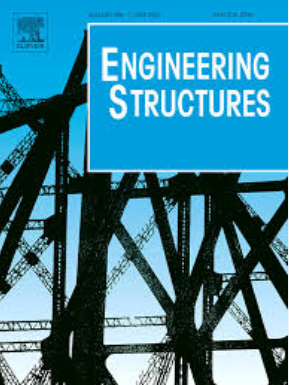考虑橡胶应变率相关性的固定蛙形间隙轮轨冲击减震装置动力性能分析
IF 5.6
1区 工程技术
Q1 ENGINEERING, CIVIL
引用次数: 0
摘要
固定道岔间隙处的轮轨相互作用具有不连续接触轨迹和非线性几何轮廓的特点,常引起频率范围宽、幅度大的瞬态冲击振动。本研究通过理论建模和现场试验相结合的方法,开发了一种轮轨冲击缓解装置(wrmd)。目的是解决接触轨迹的不连续性,促进轮轨力的均匀分布。采用参与质量法建立了50 kg/m钢轨9号道岔的瞬态滚动接触模型,并通过拉格朗日-欧拉混合方法提高了计算效率。为了解决在定义冲击指标参数方面的挑战,本研究引入了有效冲击能量概率的概念,为描述青蛙处的全局和瞬时轮轨冲击现象提供了一个全面的框架。研究发现,轮轨在间隙处由单点接触到多点接触的突变是冲击振动的主要驱动机制。wrmd具有双层设计,上部抗冲击层由锰钢制成,下部阻尼层由橡胶制成。考虑轮轨瞬态碰撞动力学,考虑碰撞速度与应变率的关系,建立了橡胶材料的超粘弹性本构模型。通过准静态和动态相结合的分析,确定了阻尼器的最佳高度。仿真结果表明,安装阻尼器后,冲击指数降低5.57 %,总冲击能量降低23.9 %。在极端操作条件下的安全评估证实,该阻尼器符合所有操作安全标准。现场安装的减振器,通过螺栓和胶粘接固定,表明它有效地减少了100 Hz以上的中频和高频振动,测量到蛙形振动减少了约9 dB,枕木振动减少了6 dB。该研究进一步揭示了道岔下部结构的隔振作用,并提出了一种新颖的解决方案,用于管理固定蛙的瞬态轮轨碰撞。本文章由计算机程序翻译,如有差异,请以英文原文为准。
Dynamic behavior analysis of the wheel-rail impact mitigation device for fixed frog gaps incorporating rubber's strain rate dependency
The wheel-rail interaction at the gap in the frog of fixed turnouts is characterized by discontinuous contact traces and nonlinear geometric profiles, which often induce transient impact vibrations with broad frequency ranges and significant amplitudes. This study develops a Wheel-Rail Impact Mitigation Device (WRIMD) through a combination of theoretical modeling and field testing. The aim is to address the discontinuity in contact traces and promote uniform distribution of wheel-rail forces. A transient rolling contact model for a 50 kg/m rail No. 9 turnout, integrating the bogie and frog, was constructed using the participating mass method, with computational efficiency enhanced through a hybrid Lagrangian-Eulerian approach. To address challenges in the definition of impact index parameters, this study introduced the concept of effective impact energy probability, providing a comprehensive framework for characterizing both global and instantaneous wheel-rail impact phenomena at the frog. The study identified the abrupt transition between single-point and multi-point wheel-rail contact at the gap as the primary driving mechanism for impact vibrations. The WRIMD has a dual-layer design, with an upper impact-resistant layer made of manganese steel and a lower damping layer made of rubber. Considering transient wheel-rail impact dynamics, a hyper-viscoelastic constitutive model for the rubber material was formulated by incorporating the relationship between impact velocity and strain rate. The optimal height of the damper was determined through a combined quasi-static and dynamic analysis. Simulation results indicated a 5.57 % reduction in the impact index and a 23.9 % decrease in total impact energy when the damper was implemented. Safety assessments under extreme operational conditions confirmed that the damper met all operational safety standards. Field installation of the damper, secured by bolting and adhesive bonding, demonstrated that it effectively reduced medium- and high-frequency vibrations above 100 Hz, with measured reductions of approximately 9 dB in frog vibration and 6 dB in sleeper vibration. This research further reveals vibration isolation in turnout substructures and presents an innovative solution for the management of transient wheel-rail impacts in fixed frogs.
求助全文
通过发布文献求助,成功后即可免费获取论文全文。
去求助
来源期刊

Engineering Structures
工程技术-工程:土木
CiteScore
10.20
自引率
14.50%
发文量
1385
审稿时长
67 days
期刊介绍:
Engineering Structures provides a forum for a broad blend of scientific and technical papers to reflect the evolving needs of the structural engineering and structural mechanics communities. Particularly welcome are contributions dealing with applications of structural engineering and mechanics principles in all areas of technology. The journal aspires to a broad and integrated coverage of the effects of dynamic loadings and of the modelling techniques whereby the structural response to these loadings may be computed.
The scope of Engineering Structures encompasses, but is not restricted to, the following areas: infrastructure engineering; earthquake engineering; structure-fluid-soil interaction; wind engineering; fire engineering; blast engineering; structural reliability/stability; life assessment/integrity; structural health monitoring; multi-hazard engineering; structural dynamics; optimization; expert systems; experimental modelling; performance-based design; multiscale analysis; value engineering.
Topics of interest include: tall buildings; innovative structures; environmentally responsive structures; bridges; stadiums; commercial and public buildings; transmission towers; television and telecommunication masts; foldable structures; cooling towers; plates and shells; suspension structures; protective structures; smart structures; nuclear reactors; dams; pressure vessels; pipelines; tunnels.
Engineering Structures also publishes review articles, short communications and discussions, book reviews, and a diary on international events related to any aspect of structural engineering.
 求助内容:
求助内容: 应助结果提醒方式:
应助结果提醒方式:


